|
Sensorial and critical tasting of wine is a practice requiring commitment,
concentration, attention and - last but not the least - passion and curiosity.
In such a vast wine scene, made of hundreds of different grapes leading -
unavoidably - to the production of a virtually endless quantity of different
wines, understanding their characteristics is very important. A condition which
can also become even more difficult because of the huge quantity of grapes used
for the production of wines in the world: only in Italy can be counted about
five hundred different varieties. Many of them, of course, have a modest wine
making use and, in many cases, even unique, however each of them has a proper
wine making dignity and, as such, it is worth to be considered. The most common
varieties increase - as a matter of fact - both difficulty and possibility of
study.
Sensorial tasting of monovarietal wines - that is the ones produced with just
one variety - has a high educational value for every taster. The study of these
particular wines, despite this can be seen as simple and easy,
offers extremely broad and virtually endless conditions of analysis. The
tasting of monovarietal wines - in order to understand their characteristics -
cannot be done by just evaluating one sample or bottle. Like it is commonly
known, and this certainly is one of the many interesting aspects of wine making
and viticulture, a variety can have different and significant interpretations
in function of environmental, cultural and enological conditions. To this we
can also add the variable factors added by each vintage: the results become
virtually endless.
The peculiar characteristics of each variety can in fact change - even
drastically - in function of these factors, although remaining, in certain
aspects, fully recognizable. In other words, wines produced from Pinot Noir in
Burgundy can be pretty different from those produced in Oregon, despite many of
the typical characteristics of this variety will be recognizable in both cases.
The same is true for every other variety: the specific characteristics of each
grape will however be recognizable no matter of viticultural, environmental and
enological conditions and factors. Another significant example is given by
Merlot. Its renowned roundness, capable of giving wines an unmistakable
smoothness, can be perceived also in wines produced in conditions, places and
vintage being so different one from each other.
The study of monovarietal wines is also fundamental for understanding the vast
category of multivarietal wines, produced by using many varieties and according
to specific wine making techniques. Knowing how to recognize the peculiar
characteristics of each grape is therefore fundamental for the understanding
and the evaluation of these wines, playing a very important role in the wine
making scene. On this regard it should be noticed what it is considered by many
a sort of magic attitude in which someone can tell a wine, area and
vintage by simply watching the color or smelling the glass. This is of course
possible, however it is something mainly associated to common belief instead to
reality. It is not however a supernatural quality, indeed, it is the result of
years spent in tasting wines and in a very strict and analytical way.
Superficiality, it should not be forgotten, does not get along with analytical
and sensorial tasting.
|
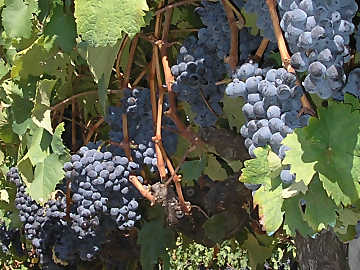 | |
| Clusters of Sangiovese: among the most
common grapes in Italy, its wines offer remarkable possibilities for the study
and understanding of varietal and territorial diversity | |
|
There are varieties, in their evident and immediate character, being easier
to recognize even after having tasted their wines for few times. On the
contrary, there are varieties being more difficult to understand and
less expressive: the skill required to recognize them takes a long time and
practice: in certain cases, the risk of being mistaken with another grape is
pretty high. It is about a study journey to be done step by step and, as such,
it is best to begin by tasting varieties having unmistakable qualities. On this
regard, it is good to taste all of aromatic varieties, that is the grapes which
wines have a clear and evident aroma of grape. Because of the low number of
grapes belonging to this category, their study is simple and very effective.
Aromatic varieties, for the sake of clearness, are Muscat Blanc,
Gewürztraminer and Brachetto.
Let's begin this type of study and, to do so, we will compare three wines
produced with these grapes, belonging to the same vintage and vinified as dry.
This is a fundamental aspect, as Muscat Blanc and Brachetto are frequently
vinified as sparkling, in particular in Italy. It is not required the three
wines to be from the same territory or country: in this case we are interested
in studying the aromatic characteristic of these grapes and their wines. This
does not mean all the wines produced with these grapes have the same
organoleptic qualities. With time we will understand also these grapes - having
a strong and intense character - can have remarkable differences in function of
the territory and vintage. In the beginning it will be enough to understand the
peculiar characteristics of each of them by comparing the three wines one to
each other in order to understand their analogies and differences.
We can start from simple things while considering the huge variability of
aromatic grapes in function of the many viticultural and wine making factors.
The next step we can do - after having made friends with the three
aromatic varieties - is to focus our study on just one of them. In order not to
introduce disturbing elements which could excessively affect the result of the
evaluation, in the beginning it is better to avoid wines produced with
particular wine making techniques, such as the use of cask and barrique. These
elements in fact give wines organoleptic characteristics which can change -
sometimes even drastically - the specific qualities of grapes. It is better to
pay attention on territorial and viticultural differences, last but not the
least, wines produced in different vintages as well. The important thing is
that wines are produced with inert containers, such as steel or cement.
We may consider, for example, Gewürztraminer wines produced in three
different areas, such as South Tyrol, Rhine Valley and Alsace. In case we want
to broad our possibilities of study, we may also add Gewürztraminer wines
produced in Sicily and Australia, in order to have a better idea offered by
different territories. The fundamental factor is that wines must be produced in
inert containers and possibly belonging to the same vintage or however in
vintages of adjacent years. Wines produced with the same variety and coming
from different areas, let us understand the influence of climate and how the
heat and cold affect not only aromas but also body. The same consideration can
be done for vintage, its meteorological condition and the period of harvesting.
A method of study that, it should be noticed, is valid for every variety,
despite studying aromatic grapes certainly is easier than non aromatic grapes.
By practicing and with time, we can increase the difficulty by studying
monovarietal wines produced in wood containers, such as cask and barrique. At
this point we should be able to recognize the main characteristics of the
varieties we are studying and we can therefore try to spot their organoleptic
qualities by isolating the contribution of wood. This exercise can be
considered simple, as one can think the recognition of the organoleptic
qualities of wood are evident and obvious, therefore easily recognizable.
Indeed, despite in certain cases the influence of wood is excessive, therefore
dominant, time and responsible use of cask may introduce light and
harmonic organoleptic characteristics, in a way to pass completely unnoticed to
the superficial taster.
By continuing the study of monovarietal wines, another interesting exercise is
represented by the evaluation of four samples - produced by the same winery and
in the same area - having different wine making characteristics. For example,
we could examine four bottles made from the same variety of which one being
young and vinified in inert container, another one being young and aged in
wood, then the same wines aged for some years in bottle. This exercise offers
the possibility of understanding how a variety can evolve with time and in
function of how it was vinified, while considering, in any case, the peculiar
and specific characteristics of their respective vintages. In theory, the
exercise should be done for every territory in which the variety being studied
is significantly cultivated, while taking into account the peculiar
characteristic of the variety will always be found according to the
interpretation of vintage and grape.
By considering what has been said so far, it is clear case studies are
countless and, as such, it is not simple - although not impossible - to
remember everything and to treasure our tasting experience. On this regard it
is useful to make use of that trick every taster should never stop
using: writing down his or her own impressions and to take note. A simple and
effective method, our notes will be always useful whenever we are about to
taste a wine produced with the varieties of which we have written down our
personal and sensorial impressions. In order to quickly retrieve our past
tasting experiences when we need them, it certainly is good to catalog and
order them in a functional and practical way.
The study of monovarietal wine is not a practice reserved to beginners only.
This type of study, in all of its countless variables, follows - like to say -
the life of every taster. Not only a fundamental exercise for the understanding
of each variety in function of the territory and the many productive factors,
but also a useful practice for improving our skills and training. Moreover,
tasting monovarietal wines is fundamental for the understanding and study of
the ones called multivarietal, that is produced by blending different
grapes. Knowing each variety and its wine making expression will in fact be
useful for recognizing them in those wines in which they are used with other
grapes. After all, it is not possible to recognize a grape or territory in case
you do not know it or you never tasted it. Recognizing a variety among many
others is a remarkable satisfaction, the right reward for the time spent in
this type of study.
|


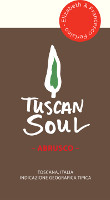
 Abrusco
Abrusco Deep ruby red color and nuances of ruby red, impenetrable to light.
Deep ruby red color and nuances of ruby red, impenetrable to light. Intense, clean, pleasing and refined aromas, starts with hints of black cherry,
blackberry and blueberry followed by aromas of plum, violet, vanilla, tobacco, pink
pepper and mace.
Intense, clean, pleasing and refined aromas, starts with hints of black cherry,
blackberry and blueberry followed by aromas of plum, violet, vanilla, tobacco, pink
pepper and mace.
 Good correspondence to the nose, tannic attack and however balanced by
alcohol, good body, intense flavors, pleasing roundness.
Good correspondence to the nose, tannic attack and however balanced by
alcohol, good body, intense flavors, pleasing roundness.
 Persistent finish with flavors of black cherry, blackberry and blueberry.
Persistent finish with flavors of black cherry, blackberry and blueberry. 18 months in barrique, 8 months in bottle.
18 months in barrique, 8 months in bottle. Roasted meat, Broiled meat and barbecue, Stewed meat, Hard cheese
Roasted meat, Broiled meat and barbecue, Stewed meat, Hard cheese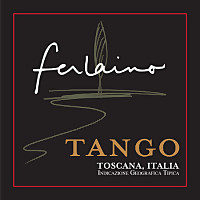
 Merlot (58%), Cabernet Franc (25%), Petit Verdot (10%), Teroldego (7%)
Merlot (58%), Cabernet Franc (25%), Petit Verdot (10%), Teroldego (7%) Intense ruby red and nuances of garnet red, little transparency.
Intense ruby red and nuances of garnet red, little transparency. Intense, clean, pleasing and refined, starts with hints of black
currant, black cherry and plum followed by aromas of violet, vanilla,
blueberry, tobacco, chocolate, mace and eucalyptus.
Intense, clean, pleasing and refined, starts with hints of black
currant, black cherry and plum followed by aromas of violet, vanilla,
blueberry, tobacco, chocolate, mace and eucalyptus.
 Properly tannic attack and however balanced by alcohol, good body,
intense flavors, pleasing roundness.
Properly tannic attack and however balanced by alcohol, good body,
intense flavors, pleasing roundness.
 Persistent finish with flavors of black currant, black cherry and plum.
Persistent finish with flavors of black currant, black cherry and plum. 18 months in barrique, 8 months in steel tanks, at least 8 months in
bottle.
18 months in barrique, 8 months in steel tanks, at least 8 months in
bottle.
 Roasted meat, Stewed and braised meat, Hard cheese
Roasted meat, Stewed and braised meat, Hard cheese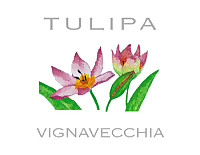
 Sangiovese
Sangiovese Intense pale pink color and nuances of pale pink, transparent.
Intense pale pink color and nuances of pale pink, transparent. Intense, clean and pleasing aromas, starts with hints of cherry, plum
and blackberry followed by aromas of raspberry, strawberry and cyclamen.
Intense, clean and pleasing aromas, starts with hints of cherry, plum
and blackberry followed by aromas of raspberry, strawberry and cyclamen.
 Good correspondence to the nose, crisp attack and however balanced
by alcohol, good body, intense flavors.
Good correspondence to the nose, crisp attack and however balanced
by alcohol, good body, intense flavors.
 Persistent finish with flavors of cherry, raspberry and plum.
Persistent finish with flavors of cherry, raspberry and plum. 6 months in steel tanks, 2 in bottle.
6 months in steel tanks, 2 in bottle. Meat appetizers, Pasta with fish, Roasted fish, Dairy products
Meat appetizers, Pasta with fish, Roasted fish, Dairy products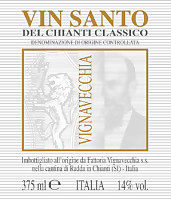
 Malvasia Bianca
Malvasia Bianca Deep amber yellow color and nuances of amber yellow, moderate
transparency.
Deep amber yellow color and nuances of amber yellow, moderate
transparency.
 Intense, clean, pleasing, refined and elegant, starts with hints of
raisin, dried fig and caramel followed by aromas of almond, date, honey,
vanilla, lavender, walnut, citrus fruit peel, tobaco and nail polish.
Intense, clean, pleasing, refined and elegant, starts with hints of
raisin, dried fig and caramel followed by aromas of almond, date, honey,
vanilla, lavender, walnut, citrus fruit peel, tobaco and nail polish.
 Sweet and round attack, however balanced by alcohol, full body, intense
flavors, pleasing crispness.
Sweet and round attack, however balanced by alcohol, full body, intense
flavors, pleasing crispness.
 Persistent finish with flavors of raisin, dried fig and date.
Persistent finish with flavors of raisin, dried fig and date. 5 years in caratelli barrels.
5 years in caratelli barrels. Jam and dried fruit tarts, Hard and piquant cheese
Jam and dried fruit tarts, Hard and piquant cheese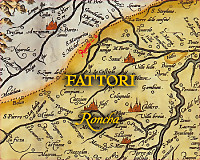
 Garganega (50%), Pinot Grigio (20%), Trebbiano di Soave (20%), Durella (10%)
Garganega (50%), Pinot Grigio (20%), Trebbiano di Soave (20%), Durella (10%) Brilliant straw yellow color and nuances of straw yellow, very
transparent.
Brilliant straw yellow color and nuances of straw yellow, very
transparent.
 Intense, clean, pleasing and refined, starts with hints of apple, plum
and hawthorn followed by aromas of pear, pineapple, broom, peach, almond
and mineral.
Intense, clean, pleasing and refined, starts with hints of apple, plum
and hawthorn followed by aromas of pear, pineapple, broom, peach, almond
and mineral.
 Crisp attack and however balanced by alcohol, good body, intense
flavors, pleasing roundness.
Crisp attack and however balanced by alcohol, good body, intense
flavors, pleasing roundness.
 Persistent finish with flavors of apple, peach and plum.
Persistent finish with flavors of apple, peach and plum. A small part of Garganega is dried for 5-6 months. Aged in cask and
steel tanks.
A small part of Garganega is dried for 5-6 months. Aged in cask and
steel tanks.
 Stuffed pasta, Broiled fish, Roasted white meat
Stuffed pasta, Broiled fish, Roasted white meat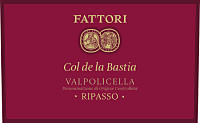
 Corvina (65%), Corvinone (15%), Rondinella (10%), Altre Uve (10%)
Corvina (65%), Corvinone (15%), Rondinella (10%), Altre Uve (10%) Intense ruby red color and nuances of garnet red, little transparency.
Intense ruby red color and nuances of garnet red, little transparency. Intense, clean, pleasing and refined, starts with hints of blackberry,
plum and black cherry followed by aromas of violet, blueberry, tobacco,
vanilla, chocolate, mace and menthol.
Intense, clean, pleasing and refined, starts with hints of blackberry,
plum and black cherry followed by aromas of violet, blueberry, tobacco,
vanilla, chocolate, mace and menthol.
 Good correspondence to the nose, properly tannic attack and however
balanced by alcohol, good body, intense flavors, pleasing roundness.
Good correspondence to the nose, properly tannic attack and however
balanced by alcohol, good body, intense flavors, pleasing roundness.
 Persistent finish with flavors of blackberry, plum and black cherry.
Persistent finish with flavors of blackberry, plum and black cherry. 18 months in cask.
18 months in cask. Roasted meat, Stewed and braised meat with mushrooms, Broiled meat and barbecue
Roasted meat, Stewed and braised meat with mushrooms, Broiled meat and barbecue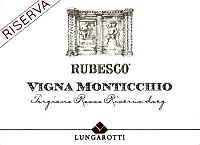
 Sangiovese (70%), Canaiolo Nero (30%)
Sangiovese (70%), Canaiolo Nero (30%) Intense ruby red color and nuances of garnet red, little transparency.
Intense ruby red color and nuances of garnet red, little transparency. Intense, clean, pleasing, refined and elegant, starts with hints of
plum, black cherry and dried violet followed by aromas of blueberry,
blackberry, raspberry, vanilla, anise, chocolate, tobacco, pink pepper,
mace, cinnamon and menthol.
Intense, clean, pleasing, refined and elegant, starts with hints of
plum, black cherry and dried violet followed by aromas of blueberry,
blackberry, raspberry, vanilla, anise, chocolate, tobacco, pink pepper,
mace, cinnamon and menthol.
 Properly tannic attack and however balanced by alcohol, good body,
intense flavors, pleasing roundness.
Properly tannic attack and however balanced by alcohol, good body,
intense flavors, pleasing roundness.
 Very persistent finish with long flavors of plum, black cherry and
blueberry.
Very persistent finish with long flavors of plum, black cherry and
blueberry.
 12 months in barrique, 4 years in bottle.
12 months in barrique, 4 years in bottle. Game, Roasted meat, Braised and stewed meat, Hard cheese
Game, Roasted meat, Braised and stewed meat, Hard cheese
 Cabernet Sauvignon (50%), Sangiovese (40%), Canaiolo Nero (10%)
Cabernet Sauvignon (50%), Sangiovese (40%), Canaiolo Nero (10%) Intense ruby red color and nuances of garnet red, little transparency.
Intense ruby red color and nuances of garnet red, little transparency. Intense, clean, pleasing, refined and elegant. starts with hints of
plum, black currant and black cherry followed by aromas of dried violet,
blackberry, blueberry, vanilla, licorice, chocolate, tobacco, leather, mace
and eucalyptus.
Intense, clean, pleasing, refined and elegant. starts with hints of
plum, black currant and black cherry followed by aromas of dried violet,
blackberry, blueberry, vanilla, licorice, chocolate, tobacco, leather, mace
and eucalyptus.
 Properly tannic attack and however balanced by alcohol, full body,
intense flavors, pleasing roundness.
Properly tannic attack and however balanced by alcohol, full body,
intense flavors, pleasing roundness.
 Very persistent finish with long flavors of plum, black currant and
black cherry.
Very persistent finish with long flavors of plum, black currant and
black cherry.
 12 months in barrique, at least 36 months in bottle.
12 months in barrique, at least 36 months in bottle. Game, Roasted meat, Braised and stewed meat, Hard cheese
Game, Roasted meat, Braised and stewed meat, Hard cheese
